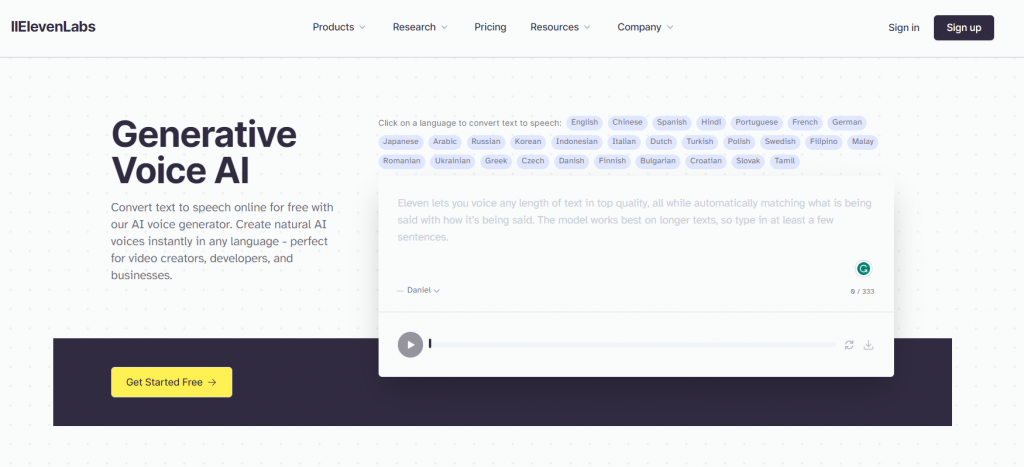Text-to-speech (TTS) technology in Zoom is a great tool. It helps change written words into spoken words. This is useful for people who find it hard to read screen text. TTS in Zoom makes meetings more accessible.
In this article, we will discuss how TTS works in Zoom. We will look at its benefits, especially for people who need it. This will help you understand and use TTS in your Zoom meetings.
Top 5 Best Text to Speech Zoom
1. TextoSpeech

TextoSpeech is a text-to-speech software designed for various applications, including Zoom. It converts text into natural-sounding speech, which is useful for creating audio content for videos, e-learning, and IVR systems.
The software offers a range of voices in over 50 languages and allows users to control speech speed, pitch, and emotion. It’s a user-friendly tool for those who need quick voiceovers without the complexity of professional recording setups.
TextoSpeech aims to simplify voiceover creation, especially for beginners and is adaptable to various content creation needs.
Features of TextoSpeech
- Supports over 50 languages and 300 voices, providing a diverse range of content needs.
- Provides an easy-to-use text editor with real-time preview for fine-tuning voiceovers.
- Flexible pricing plans, including a free version, low-cost subscription options for advanced features, and a lifetime plan.
- Natural-sounding voices that are ideal for YouTube videos and multimedia projects.
- Web-based platform, ensuring accessibility and convenience without the need for software installation.
- Fast processing speeds allow for faster turnaround on voiceover projects, increasing productivity.
Pros and cons of TextoSpeech
Pros
- Variety of Voices and Languages
- Ease of Use
- Time-Saving
- Cost-Effective
- Consistency
- Accessibility
Cons
- Limited Features in Free Version
- Lack of offline functionality
2. Speechify

Speechify is a tool that can convert text into speech. It’s perfect for use with the Zoom app. You can turn written content into spoken words when you use Speechify in Zoom meetings.
This is helpful for people who find reading hard or for times when you can’t read text yourself. The best part about Speechify is how easy it is to use. It works with different languages and has a clear voice.
This makes Zoom meetings more accessible, especially for people who prefer listening over reading. With Speechify, everyone can join in the conversation, making meetings more inclusive and easier to follow.
Features
- Speechify offers over 30 languages and a wide range of 130+ voices, including natural-sounding and celebrity-like options.
- Includes reading speed control, highlighting text as it’s read, and converting text from books, PDFs, and web pages.
- Integrates with browsers and mobile devices, allowing seamless text-to-speech conversion across different platforms.
- Offers a free version with basic features and a premium plan with advanced capabilities like more voices and offline listening.
- High-quality voice synthesis, providing clear and natural-sounding audio for various content types.
- User-friendly interface, making it easy for users of all skill levels to navigate and use the tool effectively.
- Multi-device compatibility, supporting usage across computers, smartphones, and tablets for consistent accessibility.
Pros and cons
Pros
- Accessibility
- Language Learning
- Productivity
- OCR technology
- Support for Multiple Platforms
Cons
- Naturalness of Voice
- Accuracy and Pronunciation
- Subscription Costs
- Limited Context Understanding
3. Murf AI

Murf AI is a highly recommended text-to-speech (TTS) software, especially useful for creating voiceovers for Zoom and other applications. It stands out for its lifelike and high-quality voice generation.
One of the key features of Murf AI is its ability to sync voiceovers with videos, enhancing the quality of content production. This is particularly beneficial for e-learning project managers and content creators who require professional, clear, and friendly voiceovers.
Murf AI supports over 20 languages but currently does not support voice recording. Instead, it allows users to upload recorded voices and transform them into professional-sounding voiceovers quickly.
Features
- Murf AI offers over 120 voices across 20 different languages, catering to a global user base.
- Includes voice cloning, AI dubbing, and integration with Canva for enhanced voice-over capabilities.
- Advanced text-to-speech editor, voice modulation options, and real-time voice editing for precise control.
- Flexible pricing plans, including a free trial, basic, pro, and enterprise levels, to suit different user needs.
- High-quality, lifelike AI voices are ideal for professional and personal projects.
- User-friendly interface, making it accessible for beginners and experts alike.
- Extensive library of AI voices, including options for different ages, accents, and styles.
Pros and cons
Pros
- Wide variety of voices
- Extra Effects
- Google Slides Add-on
- Performance
- Scalability
Cons
- Cost
- Learning Curve
- Reliability
- Customization
4. ElevenLabs

ElevenLabs is a text-to-speech tool that works well with Zoom. It helps people who use Zoom for meetings or webinars. This tool changes written words into spoken words. It sounds natural, like a real person talking.
Using ElevenLabs with Zoom is easy. You just need to write what you want to say. Then, the tool reads it out loud in the meeting. This is helpful for people who are not comfortable speaking.
ElevenLabs makes Zoom meetings more accessible. It helps people who have trouble speaking or hearing. With this tool, everyone can understand what is being shared. It’s a smart way to make sure everyone in the meeting can join in.
Features
- Generates high-quality audio from text using AI algorithms.
- Offers pre-designed voice profiles and the ability to create new voices from audio snippets
- For long-form content creation, such as audiobooks, with contextually-aware voices.
- Translates and preserves original voice characteristics in over 20 languages.
- Utilized by publishers and authors for AI-narrated content.
- Sets rules against misuse, supporting artistic and political speech
Pros and cons
Pros
- Human-Sounding Voices
- Versatile and Realistic AI Speech
- Voice Lab Feature
- High-Quality Audio
- Voice Library
- Intuitive Interface
Cons
- Control over the final aspects
- Huge number of features
- High Learning Curve
5. MicMonster

MicMonster is a text-to-speech tool designed for Zoom, an app for online meetings. It turns written words into spoken words. This is great for Zoom because it lets you talk without using your own voice.
It’s easy to use. Just write what you want to say, and MicMonster reads it out loud. This helps people who find speaking hard or are shy. It’s also useful when you can’t talk, like in a noisy place.
MicMonster makes Zoom meetings more accessible. It gives everyone a chance to join in, no matter if they can speak or not. It’s like having a helpful friend who speaks for you. This makes meetings better for everyone.
Features
- Over 600 voices are available, covering 140 languages and catering to diverse linguistic needs.
- Advanced AI technology enables it to infuse emotions into voiceovers, adding authenticity and reliability.
- UMicMonster offers natural, human-like voices.
- Delivers exceptional audio quality with a 384 Kbps Bitrate for an immersive listening experience.
- Offers control over the emotion and tone of voiceovers, enhancing realism and engagement.
- Allows flexibility in adjusting pitch and speed to suit specific project contexts.
Pros and Cons
Pros
- Wide Range of Voices and Languages
- User-Friendly Interface
- Speed of Conversion
- Customization
Cons
- Lack of Natural-Sounding Voices
- Limited Emotional Range
- Contextual Limitations
FAQs
How do I enable Text-to-Speech in Zoom?
To enable Text-to-Speech in Zoom, you need to access the accessibility settings in your Zoom account. Once there, look for the Text-to-Speech options and enable them. This may vary depending on your device and the version of the Zoom app you are using.
Can Zoom read out chat messages using Text-to-Speech?
Yes, Zoom can read out chat messages using Text-to-Speech. This feature is particularly useful for users who have visual impairments. You can activate this feature in the accessibility settings of the Zoom app.
Is it possible to customize the voice of the Text-to-Speech feature in Zoom?
Yes, in most cases, you can customize the voice of the Text-to-Speech feature in Zoom. This includes adjusting the speed, pitch, and sometimes the accent of the TTS voice. These settings are usually found in the same area where you enable the TTS feature.
Does Text-to-Speech work in all Zoom meetings and webinars?
Text-to-Speech should work in all Zoom meetings and webinars as long as the feature is enabled in your settings. However, the functionality might depend on the permissions set by the meeting host and the compatibility with your device.
Conclusion
The best text-to-speech tool for Zoom is one that is easy to use, clear, and fits well with the app’s features. It should make meetings more accessible and efficient for everyone.
TextoSpeech TTS stands out for its user-friendly interface and natural-sounding voices. This tool helps users follow conversations easily, making Zoom meetings more inclusive and engaging for people with different needs.

